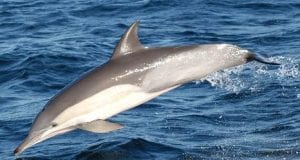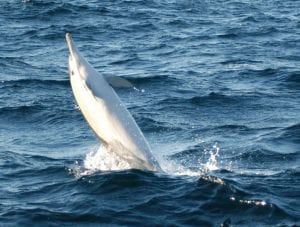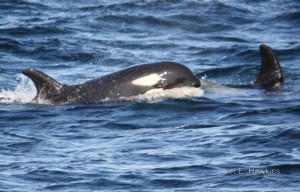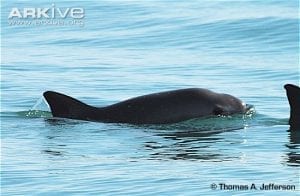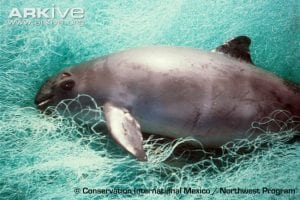Dolphin & Whale Species Fact Files
Toothed Whales
Australian humpback dolphin
Australian Humpback Dolphin
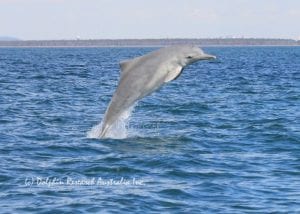
Australian humpback dolphin in the Moreton Bay Marine Park
Scientific name: Sousa sahulensis
STATUS: Vulnerable
DISTINGUISHING FEATURES
- Adults can reach up to 2.75 meters in length and weigh 260kg. Newborn calves are around 1m in length and weigh 14kg.
- Distinguished by pale grey colouration, long slender beak and low triangular dorsal fin. Adults can acquire white-pink scars that increase with age and speckling on the dorsal fin.
REPRODUCTION & BREEDING
- Gestation period of 10-12 months. Calves are highly dependent on their mothers for the first few years of life.
- It is thought that humpback dolphins reach maturity between 10-12yrs.
- Females give birth to a single calf approximately every 2-4 years.
- Humpback dolphins can live for over 40 years.
DISTRIBUTION & HABITAT
- Humpback dolphins live close to the coast within the tropical waters of Australia and Papua New Guinea. They typically are found in small groups near estuaries, deep channels, rocky reefs, in sheltered bays, open ocean and occasionally in surf zones.
DIET
- Humpback dolphins are carnivorous and feed on a variety of fish, squid and rays.
AUSTRALIAN HUMPBACK DOLPHIN SOCIETIES
- Typically found in small populations (~100) within their range and in small groups of around 4-5 individuals.
- They are very social animals and live in complex fission-fusion societies where the composition of groups can change over time.
- Humpback dolphins live in sexually-segregated societies with males forming small strongly-bonded paired-alliances and females having larger networks of associates.
- Some individuals will display preferences for certain areas and have year-round residence.
COMMUNICATION
- Dolphins produce a diverse range of sounds that include echolocation or sonar clicks, whistles, burst pulse sounds such as ‘squawks’ and ‘squeaks’.
- ‘Whistles’ are thought to be used to maintain contact, identify, and to locate other dolphins.
- ‘Clicks’ are used for echolocation, assisting in navigation and feeding.
THREATS TO AUSTRALIAN HUMPBACK DOLPHINS
- Marine mammals such as dolphins are protected in Australian waters, however, their future remains uncertain.
- The largest threats to dolphins in Australia are human pollution, habitat degradation and climate change. Many dolphin deaths in coastal waters have been attributed to ingestion of litter, boat strikes and pollutants such as insecticides.
- In other areas of the world, tuna fishing, gill netting and drift netting industries in addition to dolphin fisheries contribute to a large number of dolphin deaths each year.
Australian snubfin dolphin
Australian Snubfin dolphin
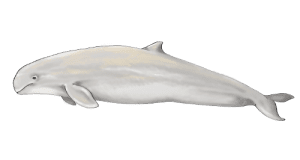
Snubfin Dolphin Illustration by E. Hawkins
Scientific name: Orcaella heinsohni
Status: Near Threatened (IUCN Red List)
Formally known as Irrawaddy dolphin the Australian snubfin dolphins were recognized as a genetically separate species in 2005.
DISTINGUISHING FEATURES
- Snubfin dolphins grow up to 2.7m and weigh 133kg. Males are typically larger than females that reach 2.3m in length and weigh 114kg.
- Snubfin dolphins are characterised by a round head, no beak or rostrum, small dorsal fin and broad, paddle-like pectoral fins.
- Snubfin dolphins have a three-tone colouration. They are dark brown along the dorsal cape and light brown on the sides with a white underbelly.
- Snubfin dolphins have conical teeth, usually less than 20 in each row.
REPRODUCTION & BREEDING
- There remains little known about this species with much of its reproductive biology including the age of maturity and longevity unknown.
- Breeding and birthing occurs all year round.
DISTRIBUTION & HABITAT
- Inhabits near-shore tropical waters from Broome in Western Australia to the Fitzroy River Queensland and parts of Papua New Guinea.
- Primarily found in shallow waters close to the coast, often near river mouths. Populations tend to be resident with individuals occupying relatively small home ranges.
DIET
- Snubfin dolphins are generalist feeders with a diet that primarily consists of fish, squid, cuttlefish, octopus and shrimp.
SNUBFIN DOLPHIN SOCIETIES
- Snubfin dolphins are generally found in small populations of less than 100 individuals.
- Typical group sizes consist of less than 15 individuals.
- Snubfins are generally shy towards boats, have low surface profiles and are generally unpredictable. They are highly social among themselves and often seen in mixed species groups with Australian humpback dolphins.
- A unique behaviour exhibited by snubfin dolphins is the spitting of water. The purpose of this behaviour remains a mystery with some theorising that it is used as a hunting tactic.
COMMUNICATION
- Snubfin dolphins produce a variety of sounds described as broadband clicks, pulses and whistles. Clicks and pulses can sound similar to creaking and buzzing when the dolphins are foraging for prey. Whistles are thought to be used to communicate between individuals and are more commonly produced during social behaviours.
THREATS
- Snubfin dolphins are protected in Australian waters, however, their future remains uncertain. Some populations have heavy contaminant loads as a result of pollution from land run-off and coastal development.
- In Australia, pollution from marine debris, litter, run-off, noise, habitat degradation, interactions with fisheries, overfishing, climate change, coastal development and vessel activities threaten the survival of snubfin dolphins.
Common dolphin
COMMON DOLPHINS
Scientific name: Delphinus delphis
Delphinus delphis leaping off Ballina in New South Wales. Image copyright Dolphin Research AustraliaDISTINGUISHING FEATURES
- Length: Adult: 1.7-2.4m; Newborn: 80-90cm
- Weight: Adult: 70-110kg
- Colouration: Common Dolphins are gray, black to brownish on their upper side. They have an hourglass colouration along their side with a yellowish patch extending from the eye to the dorsal fin and pale gray along the tail stock. They also have dark gray to black pectoral fins, tail flukes and rostrum. The under belly is white – off white in colour which can be broken by yellowish or gray lines. A dark gray line extends from the rostrum to the pectoral fins.
- Geographic variation in the colour patterns and rostrum length occurs.
- They have between 80-120 teeth on both the upper and lower jaws.
- The dorsal fin has a pointed tip and concave trailing edge.
- The dorsal fins of Common Dolphins are used to identify individuals. Each dorsal fin has a unique shape, arrangement of notches, colour patterns and scars.
DIET
- Common Dolphins feeding on a variety of fish and cephalopod (squid & octopus) species
DISTRIBUTION & HABITAT
- This dolphin species are commonly found in open ocean waters off the continental shelf in depths of 180m.
- In the Byron Bay area, these common dolphins are seasonally present. Most sightings are made during winter and spring, however, they may be occasionally seen during summer.
- Common Dolphins may be seen in groups numbering between 10 and 2,000 individuals.
- Common Dolphins may be found throughout temperate and tropical oceans worldwide.
SOCIAL ORGANISATION & BEHAVIOUR
- Common dolphins are very acrobatic species of dolphin. They are often seen porpoising, leaping, tail slapping and headlunging.
- They have been observed on numerous occasions feeding with bottlenose dolphins in the Byron Bay area.
- Common dolphins will often approach vessels to bowride.
COMMUNICATION
- Common dolphins create a wide range of sounds. Like other species of toothed cetacea, common dolphins produce whistles, echolocative clicks and burst pulse emissions. These sounds are used for communication, navigation, and feeding amongst other purposes.
THREATS
- Common dolphins are protected in Australian waters, however, their future remains uncertain.
- This species is frequently caught as bycatch in offshore fishing gear.
- In Australia, pollution from marine debris, litter, run-off, noise, habitat degradation, interactions with fisheries, overfishing, climate change, coastal development and vessel activities threaten the survival of common dolphins.
Dusky dolphin
Dusky dolphin
Scientific name: Lagenorhynchus obscurus
Conservation Status: Least concern
PHYSICAL FEATURES
- Length: Adult male: 11 m Adult female: 1.93 m
- Weight: 70- 85 kg
- Colouration: Dark grey to blue black above and white below
- Teeth: 27-36 small, pointed teeth on each side of each jaw
- Dorsal fin: The dorsal fin is curved and pointed
- Distinct features: Head is evenly sloped with no beak, distinct colour pattern, erect dorsal fin, grey flippers,
BIOLOGY & ECOLOGY
- Diett: Dusky dolphins eat a variety of prey which include, schooling fish, especially Southern Anchovy, and midwater and benthic prey such as squid and laternfishes.
- Dive depth: Dusky dolphins are known to dive to depths of at least 150 m.
- Maturity: males: 4-5 years, female: 4-6 years
- Life expectancy: 21 years
- Breeding season: Dusky Dolphins mate in Spring and they have a gestation period of about 11 months.
- Habitat: Dusky dolphins occur mainly in temperate and sub-Antarctic waters. They are known to mostly inhabit inshore waters; however, they may also be pelagic (open ocean) at times.
BEHAVIOUR & SOCIAL ORGANISATION
- Group size: 20-500
- Social: Highly social
- Behaviour: Dusky dolphins gather into large groups for feeding. They are known to use acrobatic leaps to coordinate group foraging. They commonly approach vessels to participate in bowriding.
- Unique behaviour: They are the most acrobatic of all dolphin species
THREATS
- Capture in pelagic drift-net fisheries operating in the Tasman Sea and outside Australian Territorial waters
- Entanglement in lost or discarded nets
- Entanglement in gillnet fisheries in Peru
- Illegal fishing for Dusky Dolphins off Chile
- Pollution and marine debris.
Indo-Pacific bottlenose dolphin
INDO-PACIFIC BOTTLENOSE DOLPHIN
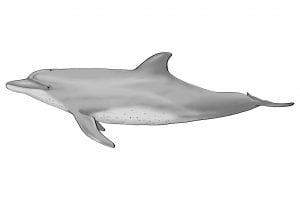
Indo-Pacific bottlenose dolphin. Artwork copyright E. Hawkins
Scientific name: Tursiops aduncus
STATUS: Near Threatened
DISTINGUISHING FEATURES
- Indo-Pacific bottlenose dolphins grow to 2.6m and weigh 230kg when mature. At birth, calves are around 1m in length and weigh between 9 and 21kg.
- Distinguished by their large curved dorsal fin, grey dorsal colouration and white ventral surface colouration. Adults have dark grey speckling on the underside that increases with age.
REPRODUCTION & BREEDING
- Female bottlenose dolphins give birth after a gestation period of around 12 months.
- A bottlenose dolphin calf will remain dependent on its mother for 2-4 years.
- Female bottlenose dolphins reach sexual maturity between 8 to 10 years and males between 10 to 12 years of age.
- Bottlenose dolphins can live for over 50 years.
DISTRIBUTION & HABITAT
- Indo-Pacific bottlenose dolphins are a coastal species that inhabit coastal areas, estuaries and bays through the temperate, subtropical and tropical regions of Australia and the greater Indo-Pacific region.
DIET
- Dolphins are carnivorous and feed on a variety of fish, squid, octopus and occasionally even crayfish.
BOTTLENOSE DOLPHIN SOCIETIES
- Indo-Pacific bottlenose dolphins are typically found in groups of 5-15 individuals. Occasional aggregations of over 100 can be encountered.
- Bottlenose dolphins are very social animals and live in complex societies that can often be sexually segregated.
- Mature males often form a strongly bonded alliance with at least 3-4 other males.
- Females live in large groups and maintain a large network of associates within their home range.
- Many communities of bottlenose dolphins will remain in small home ranges along the coastal zone and have year-round residence.
- Bottlenose dolphins can be very active at the surface and can be seen leaping, surfing and tail-slapping.
COMMUNICATION
- Bottlenose dolphins produce a diverse range of sounds that include echolocation or sonar clicks, whistles, and burst pulse sounds such as ‘squawks’ and ‘squeaks’.
- Whistles are used to maintain contact, identify, and to locate other dolphins. Indo-Pacific bottlenose dolphins have ‘signature whistles’ which are similar to a name and are unique to individuals.
- Clicks are used for echolocation, assisting in navigation and feeding.
THREATS TO INDO-PACIFIC BOTTLENOSE DOLPHINS
- Indo-Pacific bottlenose dolphins are protected in Australian waters, however, their future remains uncertain.
- In Australia, pollution from marine debris, litter, run-off, noise, habitat degradation, interactions with fisheries, overfishing, climate change, coastal development and vessel activities threaten the survival of Indo-Pacific bottlenose dolphins.
Orca
Orca or Killer Whale
Scientific name: Orcinus orca
DISTINGUISHING FEATURES
- Killer Whales are the largest members of the dolphin family.
- Length: Adult: Male 5.1-9.6m; Female 4.6-8.2m; Newborn: 1.8-2.1m
- Weight: Adult: Male 8-9 tonnes; Female up to 4 tonnes; Newborn: 180kg
- Colouration: Killer Whales have striking colouring- the dorsal (top) part of the body is black with a pale white-grey “saddle” behind the dorsal fin. Oval-shaped white eye patches are found behind and above each eye. The chin, throat, central length of the underside and the undersides of the tail flukes are also white. Individuals are able to be identified by their markings and the shape of both the saddle patch and dorsal fin.
- The mouth of the Killer Whale is large and well adapted for hunting. They have 40-50 conical shaped teeth that point slightly backwards and inwards. The upper and lower teeth interlock which aids in gripping large prey and tearing it into smaller pieces which are easier to swallow.
- The dorsal fin of a Killer Whale can reach 1.8m high in males and is shaped like an isosceles triangle. Immature male and the female dorsal fins are also large reaching about 0.91m high but are falcate (curved) in shape.
- The dorsal fins of Killer Whales often have nicks, cuts, scars and indentations which can also be used for identification.
- The paddle-shaped pectoral fins of Killer Whales are broad and rounded and can reach a length of 1.8m and a width of 0.91m.
ORCA DIET
- killer whales are carnivorous top predators.
- They are fast and skillful hunters and sometimes known as “the wolf of the sea” as they can be fierce hunters with well-organised techniques. No cases of killer Whales attacking humans in the wild have been documented.
- Unlike other species which follow regular migration routes each year, Killer Whales travel according to the availability of food.
- The diet of killer whales depends on the population and geographic area.
- Generally, transient populations will feed on a variety of animals including sea lions, elephant seals, harbour seals, porpoises, sharks, fish, penguins, smaller whales such as belugas and even large baleen whales such as grey whales. Resident populations tend to feed primarily on fish species such as salmon or herring.
- In the wild, killer whales have a lifespan of 80-90yrs (female) and 50-60yrs (male)
REPRODUCTION
- The age of maturity for killer whales varies between genders, with females reaching maturity between 11-20 years and males at 20 years of age.
- Calving season for killer whales is year-round with a peak in winter. The gestation length is generally 13-17 months while the period between calves in the wild is 3-5 years.
RANGE & HABITAT
- Killer Whales are found in all oceans of the world but are seen more often in cooler waters (especially Polar Regions) than in the tropics and subtropics.
- Sightings of these animals range from the surf zone to the open sea although usually within 800km of the shoreline.
BEHAVIOUR & SOCIAL ORGANISATION
- Killer Whales generally live in pods consisting of several females, calves, one or more males and/or juveniles. The number of individuals in a pod varies extensively from 1 to 50, although temporary joining of pods can form superpods with 150 or more individuals.
- Some pods are matrilineal in structure and consist of a mother and her offspring who stay with her for life. These resident pods are generally stable, consistent family groups with several generations travelling together. Transient pods appear to be more fluid where individuals come and go and these groups often contain unrelated females with offspring.
- Mothers are very protective of their calves and Killer Whales are known to protect and care for sick and injured companions.
- Killer whales display many different types of behaviours including breaching, lobtailing, spyhopping, tail slaps, pectoral fin slaps and dorsal fin slaps. Other behaviours of these animals include speed-swimming and logging where the whole pod faces in the same direction.
- Killer whales can travel up to speeds of 55km/h.
- Killer whales are occasionally sighted off Byron Bay in Humpback Whale season.
COMMUNICATION
- Vocalisations of killer whales fall into 3 groups- whistles, discrete calls and clicks.
- Discreet calls are thought to function as social signals between resident pod members. Call and whistle rates are highest when killer whales are socialising.
- Sound recordings have shown that each pod has its own “dialect”. Each pod has some sounds in common with other pods and other sounds that are unique to its own pod.
Spinner dolphin
Spinner Dolphin
Scientific name: Stenella longirostris
Subspecies:
- Gray’s (Hawaiian) spinners, S. longirostris longirostris
- Eastern spinners, S. longirostris orientalis
- Central American or Costa Rican spinners, S. longirostris centroamericana
- Dwarf spinner dolphins, S. longirostris roseiventris
Conservation status: Least concern
PHYSICAL FEATURES
- Length: Adult: 129 – 235 cm
- Weight: Adult: 23-79 kg
- Colouration: Spinner dolphins are grey on their upper side with a lighter grey section below it on their side running from their eyes to their tails with a white underside. They have a dark band bordered by a thin light line which runs from their eye to their flipper. However there is a large amount of variation in the colourations between regions.
- Spinner dolphins have between 45 and 65 teeth on both sides of their upper and lower jaws.
- The dorsal fin is triangular or semi-triangular with variation again among subspecies with some fins even appearing “backwards”.
BIOLOGY & ECOLOGY
- Spinner dolphins feed on a variety of fish, squid and shrimp with some populations feeding at night and diving to depths of 200-300m to catch their prey.
- They are found mostly around oceanic islands and in coastal and pelagic waters in tropical and subtropical waters in both hemispheres to around 40° N and S.
- Spinner dolphins can be found in groups exceeding 1, 000 individuals.
BEHAVIOUR & SOCIAL ORGANISATION
- Spinner dolphins, as their name suggests, are a highly acrobatic species known for their aerial displays, leaping out of the water and spinning multiple times before landing.
- They live in loose and open social organisations with some subspecies living in family groups.
ACOUSTIC COMMUNICATION
- Spinner dolphins are known to use whistles, burst-pulse signals and the well-known echolocation clicks. It is thought that the whistles and burst-pulse signals are used for communication within the social organisations unlike the echolocation clicks.
Vaquita
Vaquita
Scientific name: Phocoena sinus
Other names: Gulf of California porpoise, Cochito
Size: Adult 1,50 m, newborn 0,70 m
Weight: 30 – 55 kg
Distribution: Extreme northern end of the Gulf of California, Mexico
Diet: Fish, squid, crustaceans
Habitat: Warmer turbid waters, shallow inshore (< 40 m.) Status: Critically Endangered (IUCN, 2008) The Vaquita: small species, big problems!
The Vaquita is the smallest and most endangered cetacean in the world. With an estimation of only 250 animals left, this species could be the next to go extinct. The Vaquita is one of the six porpoise species, and lives in warmer waters. This species lives in a area less than 40 square miles, making it’s range the smallest of any cetacean living on the Earth. They survive in an area between San Felipe, Rocas Consag and the tidal mouth of the Colorado River in the Gulf of California (Mexico). Although the Gulf of California represents only 0.008% of the world’s seas, it harbors 34 species of marine mammals, like blue and fin whales as well as marine turtles. The Vaquita is an endemic species to this region, making it’s survival in this particular area incredibly important.
The northern Gulf of California owns a great abundance of fishery resources, and with 100.000 people living around its margins, some of these fishery resources are now depleting due to overfishing. This forms the biggest threat to the vaquita, especially the use of gillnets. The porpoises get caught as bycatch in these gillnets, that are set out to catch shrimps. Estimations are made that at least 39 vaquitas per year die in these nets, and maybe even as many as 84. Fishing gear is a big problem for cetaceans all over the world. Estimated is that 300,000 cetaceans drown every year in fishing gear. That equals one cetacean dying every two minutes! Of course, setting out nets is a result of the demand people put on eating seafood. Local fishers do not want to catch vaquita, the bycatch is a result of local people trying to make a living and feeding their families.
The challenge is now to protect the remaining group of vaquitas. The government of Mexico created an international committee, and a biosphere reserve and vaquita refuge in 2005 which covers nearly 2,000 square kilometers. They also put a ban on the use of gillnets, compensating the local fishermen with alternative livelihood options.
Baleen Whales
Southern right whale
Southern Right Whale
Scientifc name: Eubalaena australis
Conservation status: Least concern
Southern right whales are large, stocky baleen whales commonly found in the coastal waters of Australia between Sydney and Perth throughout winter and spring.
PHYSICAL FEATURES
- They have large heads relative to their body size, with a strongly bowed mouth and arched rostrum.
- As with all right and bowhead whales, they possess no dorsal fin. Their pectoral fins are relatively short and paddle shaped while the flukes are broad with a smooth trailing edge.
- Unique to right whales is the presence of callosities on the head (rough patches of keratinised skin) which are colonised by small crustaceans known as whale lice.
- In the southern species, these are present on the rostrum, chin, and jaws with those on the upper jaw being more discontinuous than those of northern species. The presence of callosities on the lower lip also distinguishes the two species apart.
- The size and arrangement of these callosities remains the same from birth, and is therefore used to identify individuals
- The blow of the southern right whale is relatively easy to identify, being quite short and V-shaped
COLOURATION
- Southern right whales are mostly black in colour, with white patches of varying shape and size on the belly and sometimes chin
- Due to uneven sloughing of the skin, some have light mottling
- Roughly 3-6% of individuals also have white or grey dorsal blazing
BALEEN
- These whales possess 200-270 long, narrow baleen plates on each side of the mouth (these can reach up to 3m in length)
- With fine fringes, their baleen plates range from dark grey to black
DISTRIBUTION
- Southern right whales have a circumpolar distribution between 20°S and 60°S, coming close to coastlines for breeding in winter and spring
- It is believed that they feed in the south over summer, but little is known of their offshore distribution
- In Australia, they are commonly found along coastlines between Perth and Sydney (including off Tasmania) between late April and early November
- There are believed to be two Australian subpopulations; the large south-east population of ~2500 individuals, and the smaller south-west population comprising less than 300 individuals
- Major calving grounds have been identified at Doubtful Island Bay and east of Israelite Bay in Western Australia, and in South Australia at the Head of Bight
- Whaling records reveal that the Australian population suffered a large decrease in abundance throughout the early to mid-1800s. In addition, many areas of high importance prior to exploitation are rarely used today (for example, Derwent Estuary in Tasmania)
FEEDING
- Because they are baleen whales, southern right whales feed on small crustaceans in the water column such as copepods and krill
- They do this by skim-feeding on the surface and sub-surface; swimming forward with their mouth open, causing the prey to be caught on the fine fringes of the baleen plates
- Their feeding grounds are believed to be in deep, offshore waters, possibly in sub-Antarctic areas
MATURITY & REPRODUCTION
- Life expectancy is believed to be at least 50 years for southern right whales
- Southern right whales reach physical maturity when they are around 16m long
- Sexual maturity is believed to be 7 to 8 years in females
- Females typically have one calf every three to five years, with gestation lasting for approximately one year
- Calving grounds are found in shallow areas near to shore, such as the southern coastline of Australia, most individuals have high site fidelity in that they return to the same areas each year to breed
- Mating also occurs within these calving grounds, where females mate with multiple males in a season
- Males have very large testes (up to 2m and 500kg each) and long penises, an indicator of sperm competition between males rather than direct aggression to successfully fertilise a female
BEHAVIOUR & SOCIAL ORGANISATION
- Southern right whales are known to breach often, and may slap their pectoral fins and flukes on the surface of the water before diving
- They have also been observed to “sail” by catching the wind in their raised tail flukes
- Calving whales tend to keep away from highly social groups of non-calving whales during the breeding season, but stay close to shore in shallow waters
ACOUSTIC COMMUNICATION
- Southern right whales make a variety of calls to communicate with one another
- These can be divided into two functional categories; discrete calls common for resting and swimming whales, and highly variable integrated signals most often heard by active and sexually active groups of whales
- This species can discriminate between calls of other individuals and other underwater noises, with the upcall (a discrete call) thought to be the primary contact call useful for long distance communication
- Similar to signature whistles in bottlenose dolphins, the upcall may provide information about the identity of the caller
- This call is made between calves and mothers who lose sight of one another, and is the only known vocalisation of newborn calves
THREATS & CONSERVATION
- Though listed as “Least Concern” by the IUCN Red List, southern right whales are listed as endangered in Australia under the Environmental Protection and Biodiversity Conservation Act 1999
- A number of threats to southern right whales have been identified in Australian waters;
- Entanglement
- Primarily from products of commercial fisheries and marine debris, entanglement can cause physical damage, restrict mobility and affect breathing or feeding ability
- Vessel disturbance
- This species is highly susceptible to vessel collisions which can cause serious injury or death
- Vessels can also disrupt natural behaviours and present energetic costs when individuals try to avoid vessels such as recreational boats and whale-watching vessels
- Noise interference
- Loud noises from vessels, seismic surveys and industrial activities can cause avoidance of particular habitats, interference with acoustic communication, and potentially physical damage to hearing ability
- Habitat modification
- Ports, marinas, and other infrastructure developments alter the natural environment and as a result, displace or disrupt the behaviour of southern right whales
- Runoff and discharge from industrial and urban sources can also increase exposure to harmful chemicals and pollutants
- Overfishing
- Prey sources for these species can be depleted from overharvesting by commercial fisheries, leaving not enough to sustain wild populations
Humpback whale
HUMPBACK WHALES
Scientific name: Megaptera novaeangliae
Conservation status: Least concern
Humpback whales belong to the family of baleen whales known as rorquals. These whales have long pleats (or grooves) that run from the tip of their rostrum to their navel on the underside of their body and a flat upper jaw. Rorquals are generally streamlined and slender, though the humpback is stocky and rounded with very long pectoral fins. The long pectoral fins distinguish humpbacks from other baleen whales and is the reason for the Genus name Megaptera (meaning big-winged).
PHYSICAL FEATURES
- Length: Adult: 11-17m; Newborn: 4-5m
- Weight: Adult: 25-40 tonnes; Newborn: 1-2 tonnes
- Females tend to be 1-1.5m larger than males but it is difficult to determine females from males in the wild as both have internal sex organs. Sighting the genital slits on the under-belly is required to confirm sex. The male’s genital slit is located mid-way between the anus and the navel. The female’s genital slit is located in front of the anus and is separated by feature known as a hemispherical lobe. The presence or absence of this lobe is used for sex determination.
- Humpback pectoral fins can be up to a third of the body length (approx. 3-5m) and have a series of bumps called tubercles on the leading edge.
- The dorsal fin is located approximately two thirds of the way back from the tip of the rostrum and is low and broad based, often sitting on a raised hump of tissue more obvious when they arch their back to dive.
- The tail flukes have a serrated trailing edge, these serrations along with markings on the underside of the tail fluke can be used to identify individuals.
- The rostrum is covered in golf ball sized lumps known a tubercles. Each tubercle has a stiff sensory hair or vibrissa around 1.2 to 2.6 cm long which has a rich blood supply and is connected to a nerve suggesting a function as a sensory organ – perhaps to detect current and temperature changes in the water to aid in navigation. (env.gov.au)
- Colouration: Humpback whales are black or dark grey on the upper dorsal side and they generally have large amounts of white on the ventral underside of their body, pectoral fins and tail flukes. Southern Hemisphere humpbacks tend to have more white on the underside of their body which extends further up the sides of their body.
- The unique black and white markings on the underside of the tail flukes are life fingerprints with no two being the same.
- Occasionally completely black individuals are seen in eastern Australian waters, and an all-white (probably albino) individual has been a regular visitor here in the past.
BIOLOGY & ECOLOGY
- Humpback whales occur in all oceans of the world and are separated into Southern and Northern hemisphere populations. The international whaling commission separated the southern hemisphere populations into 6 groups, 2 of which migrate along the east and west coast of Australia.
- The migratory route around Australia is close to the land usually at a depth of less than 200m and generally within 20km of the coastline.
FEEDING
- Southern hemisphere humpbacks feed almost exclusively on krill (small shrimp-like crustaceans), which occurs in vast quantities in Antarctic waters, but they also consume small schooling fish including sardines, herring, mackerel and anchovies.
- Humpback whales feed by taking take large gulps of water and prey. As they fill their mouth the throat grooves expand and the mouth balloons outward. When they bring their jaw together the throat grooves contract and the whale uses its tongue to force water through the baleen fringes and out the sides of the mouth. The fringes act as a sieve to collect prey which is then swallowed.
- Humpbacks usually feed in the top 100m of the water column mainly in polar feeding areas where there are large swarms of plankton. They have been observed feeding during migration however this is thought to be more opportunistic rather than a nutritional requirement.
FEEDING BEHAVIOURS
- Lunge Feeding – where a whale comes up from a depth at an angle to the surface and takes a large gulp of water and prey.
- They have also been observed lying on their side swimming in circles with the mouth partially open so water flows through the baleen as it swims.
- Flick feeding – where the whale herds its prey and then flicks its tail to splash down in front of the school of prey and startling the prey so it remains still as the whale engulfs it
- Bubble netting – this is where a whale dives down, then swims up in a spiral releasing bubbles of air from its blowholes. The bubbles float up in a column forming a ‘bubble net’, keeping prey inside the column. The whale lunges up through the center of the column with its mouth open. People have seen several humpback whales lunge-feeding up through a “bubble net”, one at a time.
REPRODUCTION & LIFE EXPECTANCY
- Humpbacks whales are generally observed singularly or in small groups but larger groups of 10-15 are often observed in feeding and breeding areas.
- Life expectancy is recorded as at least 48 years but is likely to be significantly longer (up to 80 years) as shown in other balaenopterids.
- They are fully grown at around 12 to 15 years and sexually mature at 4 to 8 years (average 5 yrs), at a size of 11-12m.
- After 11-12 months gestation females give birth to live young. Individual females give birth every 2-3 years. Only 1 calf which is born at a time, fluke first.
- Calves are well developed and immediately able to swim. Calves stay close to their mother for the first few days to weeks and are suckled under the water close to the surface. Calves are weaned at around 11 months. Other adults known as escorts help protect calves from predators.
BEHAVIOUR & SOCIAL ORGANISATION
- The humpback whales found off the east coast of Australia are part of the Southern Hemisphere population that generally feeds in Antarctica from December to April and migrates to the Great Barrier Reef to mate and give birth from June to October.
- They have a cruising speed of 8km/h but can reach 32km/hr in short bursts.
- In adults, dives usually last 10-15 minutes (sometimes up to 45 minutes) followed by 3-4 blows at the surface at 15-30 second intervals.
- Before a deep dive, they usually raise their flukes at the surface, known as a ‘fluke up’ dive. They are thought to dive to around 120 m.
- Their blow pattern is small and bushy and up to 4m high.
- Humpbacks are the most acrobatic of the great whales. Breaching, tail-lobbing, pectoral fin slapping and spy hopping are common behaviours. They often do full body breaches where their whole body is out of the water.
- Humpback whales can be highly active at the surface with breaching, pec slapping and tail slapping, particularly at the breeding grounds.
COMMUNICATION
Songs: The male humpback whale is famous for its extraordinarily long and complex songs which travel very far throughout the oceans. These submarine songs, composed by several elements, can last for hours. They are specific to different populations and can be heard hundreds of kilometres away. Scientists think that the humpbacks do this to communicate with other whales and to potentially attract a mate.
Humpback whales also produce a variety of different sounds for communication including low frequency grunts, moans and groans.
THREATS
- Humpback whales were subject to intensive commercial hunting until their protection in 1965 following the collapse of populations across the southern oceans. In Australia, they have been protected since 1965 and have continued to increase in abundance each year. They are one of the few species that have returned from the brink of extinction, yet their future remains uncertain due to a cocktail of threats from human activities.
- Human threats include: Entanglement in fishing gear and shark nets, boat/ship strikes, whaling, pollution, climate change, ocean noise, unsustainable tourism and overfishing.
- killer whales and sharks that prey on calves and sick/injured whales

